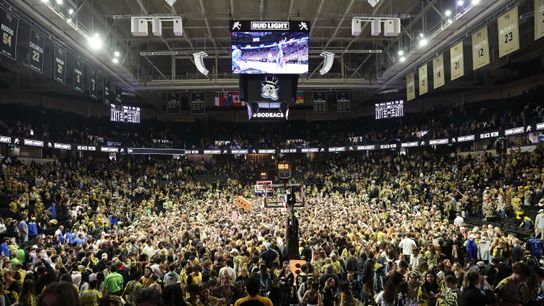Jubilant fans pouring onto the playing surface immediately following the end of a game is one of those only-in-college-sports problems that no one's found a way to stop.
The latest came over the weekend when Wake Forest's men's basketball team beat Duke, which ended with Blue Devils center Kyle Filipowski injuring his right knee in a collision with a Demon Deacons fans, with his status for Wednesday night's game with Louisville in question.
ESPN just showed a new angle of the court-storming at Wake Forest where Duke's Kyle Filipowski was injured. Can clearly see where he hurts his knee as a fan taunts him while racing to midcourt. Unbelievable. pic.twitter.com/ABAsKC2kTI
— Kyle Boone (@kyletheboone) February 24, 2024
"When are we going to ban court storming?" Duke head coach Jon Scheyer asked after the game. "How many times does a player have to get into something where they get punched, or they get pushed, or they get taunted right in the face? It's a dangerous thing."
Though the ACC does not have a rule on its books banning court storming, other conferences do. The SEC's ban has been in place for nearly 20 years, and that hasn't stopping playing-surface stormings in that league.
“It’s got to stop but it’s not going to,” ESPN college basketball analyst Jay Bilas said afterward. “There’s no appetite in college basketball to stop it. The SEC has a rule against it but the institutions are happy to pay the fine because they like the visual. And the truth is, we in the media like the visual too."
Speaking of visuals, lining the perimeter of the court or field with hundreds or thousands of law enforcement would likely solve the problem, but no one wants to see that, either.
And so the problem persists. It's only a matter of time until a student or, worse, an athlete gets seriously hurt.
Alabama AD Greg Byrne thinks he has a solution. It's a radical one, but bear with him.
“You have two kids run out there, no, but when you have a sustained rush like what just happened the other day at Wake, you lose the game,” Byrne told the Birmingham Tip Off Club, via AL.com. “That will get people to stop.”
Hitting field-storming violators with a forfeit changes the incentive structure without going to the costly and unsightly step of pointing proverbial and literal guns on your own fans. Suddenly, players, coaches, the PA announcer and, crucially, other fans are now policing the students, not the actual police.
Court and field-storming is a social activity. Kids do it because their friends are doing it. But no one wants to be ostracized because they cost their school a monumental victory.
“Kids aren’t going to be in the stands saying “Oh, I don’t want to do this because the school is gonna get fined $200,000,” Byrne said. “That doesn’t enter their mindset. But if they knew the game that they just had been a part of, celebrated a great win that led to that, if they knew that they were going to lose that game immediately, that would stop them.”
The problem is, where does one draw the line between "two kids," as Byrne referenced earlier, and a "sustained rush"?
That language would have to be clearly and explicitly laid out if a conference is going to take a win away, but otherwise I believe Byrne's idea would work.
